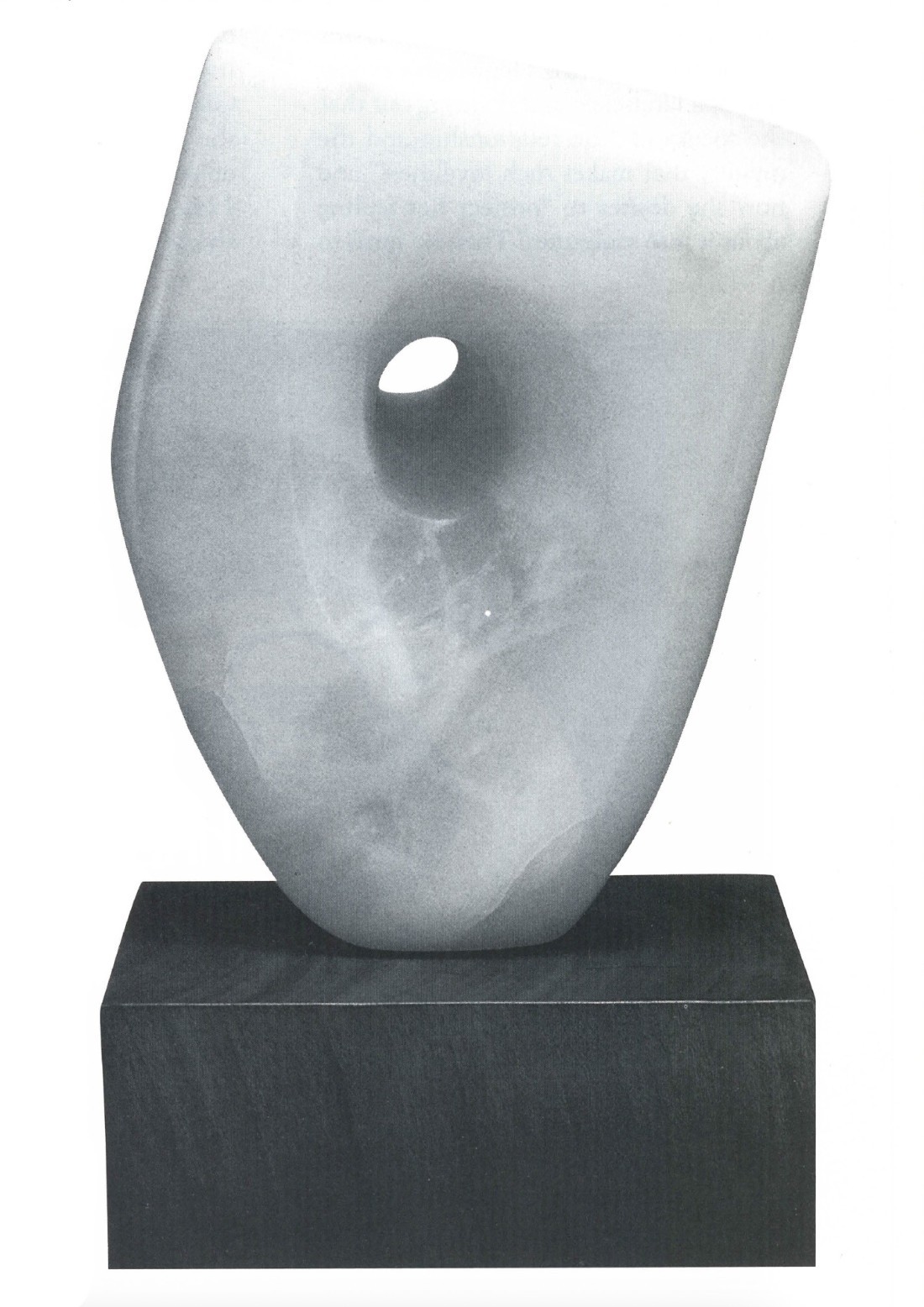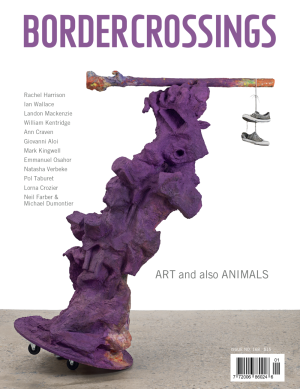Bear Breath
“Art,” wrote British sculptor Barbara Hepworth (1903-1975), “like angels, is beyond sex.” It’s an adage being everywhere discounted by visitors to and commentators upon “Barbara Hepworth: A Retrospective,” running at the Art Gallery of Ontario until August 7. Hepworth’s first retrospective since 1968, the current presentation of her work—66 carvings and bronzes along with 28 drawings—has been organized for the Tate Gallery Liverpool and for the Art Gallery of Ontario by Penelope Curtis, curator of the Centre for the Study of Sculpture at the Henry Moore Institute, Leeds, and by Alan G. Wilkinson, former curator of 20th-century art at the AGO. The exhibition is important, not just because it encourages a somewhat more objective view of Hepworth’s career and achievements, but because it posits the late Dame Barbara as a protagonist of almost tragic dimensions in a richly nuanced drama about the agon of identity and the fate of female power in the obstacle race that is art history.

Barbara Hepworth, Three Forms, 1935, Serravezza marble, 20 x 53.3 x 34.3 cm. Collection: Tate Gallery.
Hepworth might well have been irritated by the well-meaning but subtly condescending way her work is being presented to the public. A flyer from the AGO shows a pensive, girlish Hepworth (hairband and modest string of pearls) gazing ruminatively into (and beyond) a dark and toweringly massive sculpture that, while it is assuredly one of hers, nevertheless looks like a work by her chiefest rival. “Barbara Hepworth,” reads the copy, “carved out her place next to Henry Moore.” However true this may be in the broad art-historical sense, it somehow manages to turn Hepworth into the sculptor-equivalent of a tiny consort to a prodigious Egyptian pharaoh. Some of the headlines of English reviews of this exhibition are daintily dismissive just when they mean to be, apparently, supportive: “A Woman’s Place,” intones the London Times sagely, “Is in the Stone.” And there is a lot of quoting of Hepworth’s tepid feminism (can we really call it that? Probably not. It’s more a form of special pleading within the mannist status quo) in which she raises her cultivated voice to claim a position at least adjacent to the mighty masculine forge of creation: “This belief in the inevitable inferiority of women’s art presupposes a competitive element between the sexes. I believe they have a sensibility, a perception and contribution to make which is complementary to the masculine and completes the total experience of life.” Completes it, by adding softness, smallness and grace. Hepworth’s friend and presumed supporter Herbert Read, in the introduction to Barbara Hepworth: Carvings and Drawings (Lund Humphries, 1952), delimits her in a way that is now classic: he quotes from Unit One, a 1934 manifesto of British artists and architects, citing Hepworth’s evocation of a landscape and pointing out that she speaks of “the relationship and the mystery that makes such loveliness” and how she desires to “project her feeling about it into sculpture.” Then he turns to Moore’s statement in the same manifesto. In Moore, Read emphasizes, we find a similar concern for nature, but instead of mystery or loveliness we get an explicit disclaimer of beauty. “For Moore,” exults Read (who has clearly forgotten whose introduction he’s actually writing), “beauty of expression [identified with Hepworth] aims at pleasing the senses,” while “power of expression” [Moore country] “has a spiritual vitality which for me is more moving and goes deeper than the senses.” Alas, poor Barbara, I knew her, Horatio!
Influenced by the under-acknowledged work of her first husband, John Skeaping, by the imperious clarities of her next husband, Ben Nicholson, and then, of course, by sometime lover Henry Moore, Hepworth is now asked—in the scholarly glades of Revaluation—to shoulder two more influences: Naum Gabo (who lived nearby in London) and Alberto Giacometti. Let’s see now. From Gabo, she got the strings with which she laced up some of her best works (like Pelegos, 1946 and Wave, 1943). From Nicholson she got (so the scholarly story goes) permission to add discrete bits of colour to her sculptures—like Sculpture with Colour (Deep Blue and Red), 1940. From Giacometti—and his influence upon her is Alan Wilkinson’s major contribution to the current catalogue—she took a kind of drama. And (inevitably) softened it. Speaking of her Two Segments and Sphere, 1935-1936, Wilkinson writes that, in comparison to Suspended Ball (clearly the work’s progenitor), “the sexual overtones are somewhat muted, without the suggestion of painful, erotic pleasure implicit in Giacometti’s Suspended Ball.” Poor Barbara. Always a bridesmaid, and never a bride.

Holed Stone, 1959, alabaster, 35.6 cm. Collection: Art Gallery of Ontario.
But there is one revaluation of Hepworth’s work that really does seem to count for something. It is beginning to seem clear that if Moore is the begetter of the reclining figure archetype it was probably Hepworth, and not Moore, who first drilled a meaningful hole through a piece of stone—in the otherwise lumpy and altogether humdrum Pierced Form of 1931. (“I had felt the most intense pleasure in piercing the stone in order to make an abstract form and space….”) It’s a breakthrough which has been lost in the art-historical shuffle, and will doubtless continue to be, at least in the minds of the gallery-going public. By 1970, five years before her death-by-fire in the immolation of her studio (a fizzled gotterdammerung which would have forever deified a male sculptor—like Moore—but which, in Hepworth’s case, everybody has simply forgotten about), the artist was complaining bitterly about the lack of support and appreciation she was receiving at the hands of the British art establishment. Her installation in the British pavilion in Venice in 1959 had been, “too damn ladylike.” “Apart from being a woman, it has not been easy, always having great bears breathing down one’s neck!” It is doubtful whether, the current exhibition and critical study notwithstanding, it’s ever going to get any easier for Barbara Hepworth—even as a restless, posthumous spirit. ♦
“Barbara Hepworth: A Retrospective” is on exhibition at The Art Gallery of Ontario through August 7, 1995.
Gary Michael Dault is a frequent contributor to Border Crossings from Toronto.

